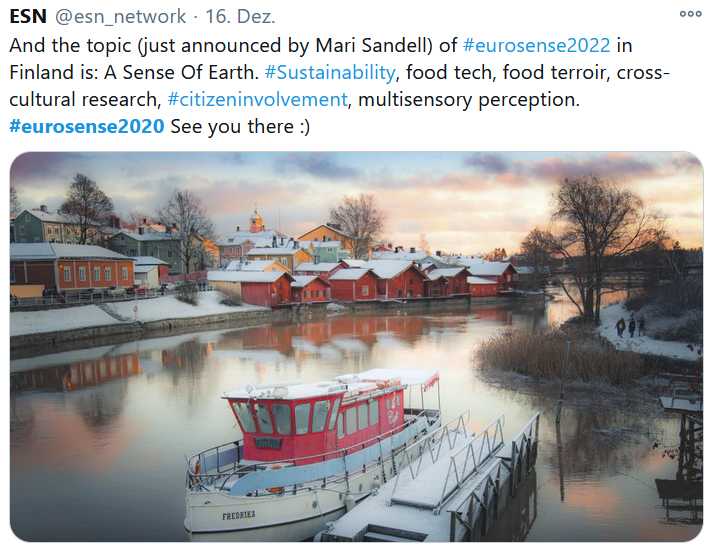EuroSense 2020 summary
“We are where the action is”
From Sunday, the 13th to Wednesday the 16th of December 2020, around 700 people attended the first virtual EuroSense conference. The conference was hosted by Kees de Graf and Betina Pequieras-Fizsman from Wageningen University.
[Download as PDF]

With around 150 posts, the attendees commented about the ongoing conference via Twitter, using the hashtag #eurosense2020. Here is an edited and commented version of the Twitter stream, a so called Twittary.
Relaxed setting
Entering the conference, setting up a profile and switching between sessions – all went quickly and smoothly. Kees de Graf and Betina Pequieras-Fizsman opened the conference in a comfy setting, with a (virtual) open fire in the background, a Christmas tree on the table and a cup of tea in their hands. One attendee tweeted, “Attending a conference in my pj’s”, summarizing the relaxed setting of an online conference. The attendees tuned in from all over the world, from Singapore to Australia, from the USA to South Africa. For some attendees it was in the middle of the night.


Fried by lightning - The future of food
The first keynote speaker, Sam Bompas, talked about what we would eat in 10 years. He took the audience through some of the hottest future trends. Some of them – such as grilling by lightning – probably won´t make it into the next decade, but in general, food and eating – fueled by social media – could gain even more of an event character that invigorates all the senses. And: 3D food printing will gain in importance. (Do you notice the odor organ in the background of his video?)
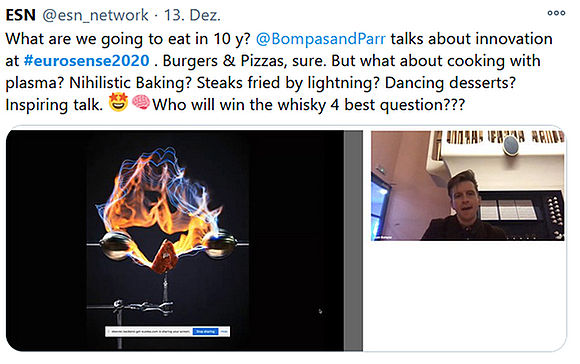
In the next keynote, Suzanne Higgs from the University of Birmingham took us through a tour de force of the food-brain-connection. She addressed – from a neuroscience point of view – what sensory researchers experience everyday while testing consumers: How we value food depends on many variables and taste is just one of them.
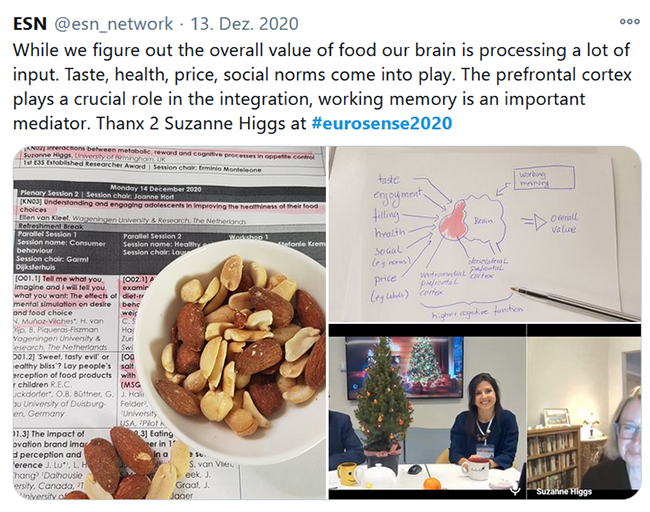
On day 2, Ellen van Kleef from Wageningen University introduced us to the influence of Social Media on food choice in teenagers. Social Media has a huge impact on teenagers. Could it be used to make them eat healthier?
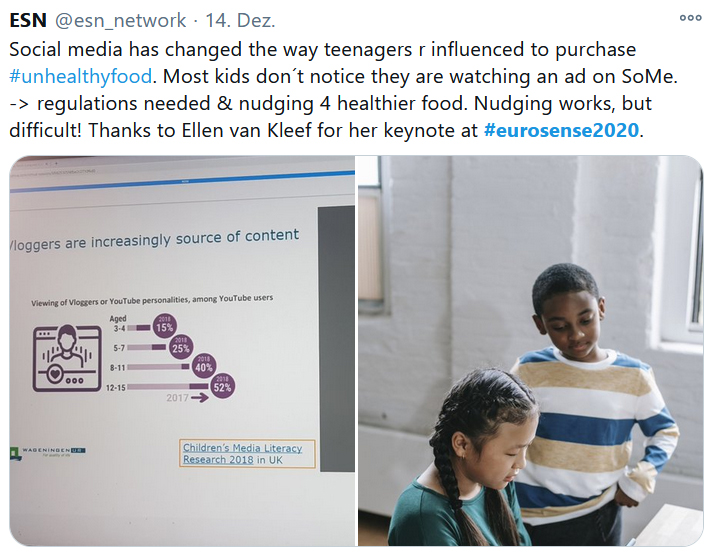
The question-and-answer tool, with which everybody could pose questions online during and after a talk, proved to be a fantastic way to interact with one another. The questions were then discussed later. Some of the questions and comments highlighted important aspects of the presented data. It would be great to transfer this tool to the next “real” conference.
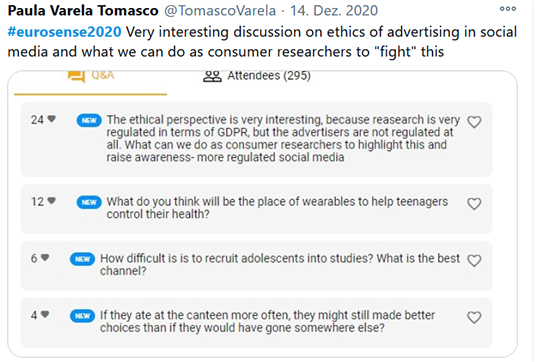
Later that day we used the refreshment break to make people aware of poster presentations by our members, for example:

After the keynote, attendees had to decide between three parallel workshop sessions. But the decision wasn´t as hard as usual because each session was recorded and could be visited at another time in the following four weeks. This is another helpful feature that should be implemented during “live” as well as online conferences.
Open innovation
At the workshop session about “open innovation”, the session chair Stefanie Kremer (Friesland Campina) emphasized what needs to happen to create new and healthier products.
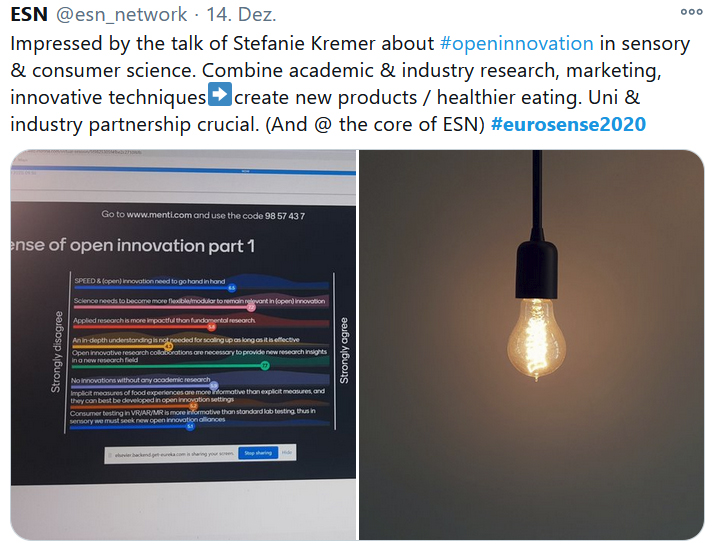
Prof. Lisbeth Zandstra, who works at the Unilever Innovation Center as well as at Wageningen University, gave an example of how partnerships between industry and universities can push important research forward.

At the European Sensory Network, we had already started a few years ago to investigate the role of Virtual Reality in consumer testing. At the last EuroSense, we organized a workshop around the topic. During EuroSense 2020, VR seemed to attract less of a buzz. But even when it has lost some of its novelty appeal, VR applications have made their way into sensory and consumer research. Daisuke Kaneko from Kikkoman Europe R&D Laboratory (situated near Wageningen University) gave an impressive example of this.

Before and after the open innovation workshop, the audience was asked via menti.com to answer a couple of questions related to the topic. Did their opinions change because of the presentations?
The results showed that for some questions the disagreements seemed to have become even more pronounced. While a part of the audience thought that innovations should always go hand in hand with academic research, another part of the audience disagreed.
From consumers to co-creators – new trends in product development
After the flash poster session, the afternoon sessions started. Let´s peek into the workshop “Consumers’ involvement towards future food systems”, chaired by Paula Varela (Nofima). Mari Sandell from the University of Turku presented a project that involved citizens in food innovation.
It is called Flavoria®, and reminded some people of the Restaurant of the Future at Wageningen.It brings together five faculties from the University of Turku (Medicine, Education, Social Science, Science and Engineering, Economics). Their website describes “Flavoria® as “a multidisciplinary research platform at the University of Turku that can be used for producing new scientific knowledge and consumer understanding for the sustainable development of both society and business.”

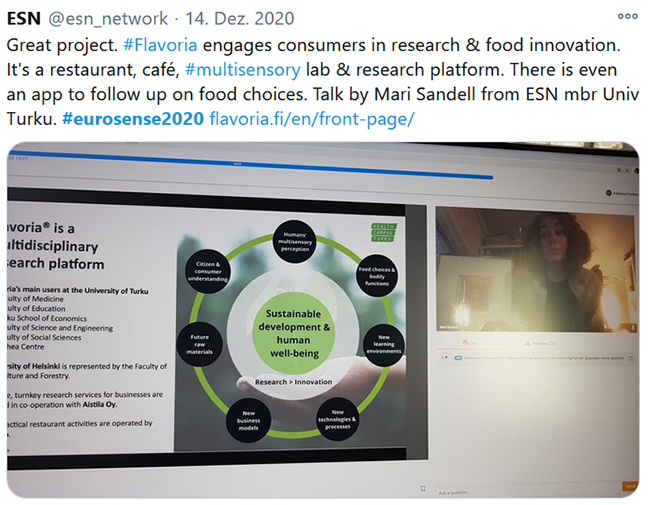
Many of the participants who viewed the inspiring presentation would have certainly enjoyed seeing this new center/restaurant with their own eyes. That desire will become reality. The next EuroSense will take place in Turku, Finland. Mari Sandell´s talk served as a good introduction to the vibrant sensory scene in Finland and whetted our appetites.
ESN-funded study
Usually, if you want to switch sessions during a live in-person conference, you leave the lecture hall on your tiptoes and try to find the other lecture hall. Not so at an online conference. You click twice, and you sit in a parallel session. That makes it much easier to do session-hopping without getting stressed. That is exactly what we did, since in the parallel session, “implicit measures”, Mads Pedersen (Nofima) was going to present the latest ESN-funded study.
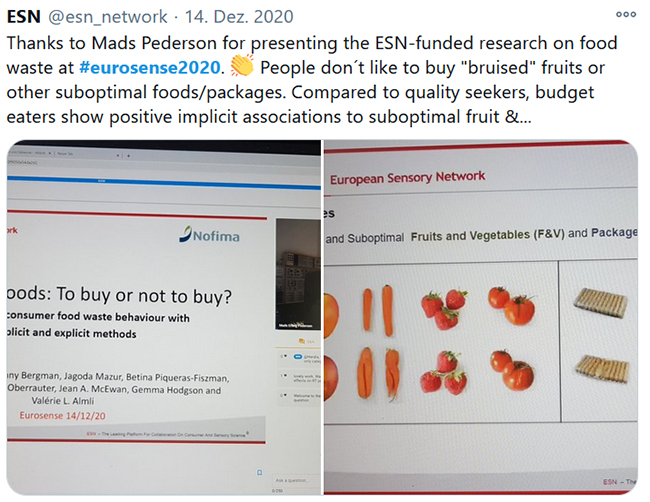
…veggies. A low-price strategy on suboptimal fruits and vegetables may appeal to consumers in the budget eater segment.
Over 400 people viewed the tweet. At ESN, we are proud that we attract such dedicated and brilliant researchers.
For two hours in the late afternoon, the attendees had the chance to visit the virtual poster sessions. Just as in “real life”, you could bump into other participants.

Yet, the poster sessions were missing some of the hustle and bustle of a real-life conference. Also, it can be difficult to stay concentrated when you are listening to virtual talks and staring nonstop at a screen all morning. The desire to visit posters at the end of a full day is probably less than in a live conference. It would be worthwhile to try out different formats for presenting posters at a virtual conference.
To remind everybody about the good old pre-Covid times, we posted a photo of the poster session at EuroSense 2018. But that just caused confusion, since some followers thought the conference was really taking place in Rotterdam, despite the pandemic.
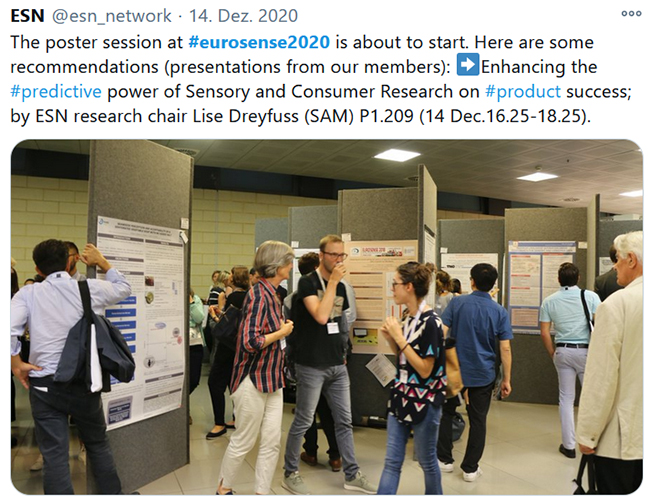
Just a reminder that 3D food printing is having an impact. Ching Yue Chow, Wender Bredie and colleagues from the University of Copenhagen showed that a bilayer lemon mousse with unequally distributed citric acid could increase consumption compared to a simpler mousse, therefore stimulating food intake in patients. The research group is currently experimenting with using 3D food printing to develop protein-enriched lemon mousses and yogurt snacks.

The nose knows
On the third day of EuroSense, Sanne Boesveldt from Wageningen University took up the cudgels for the sense of smell with her talk “The nose knows: olfactory influences on eating behavior and food navigation”. This neglected sense needs all the help it can get. Whoever has visited a conference dedicated to the sense of vision knows how skewed the public perception is of the two areas of research. In her keynote she reminded us that Humans are macrosmats, and that we are even able to smell the fat content of milk. (Apropos smell, we just published a video on feelings and fragrances.)

We are glad that, with over 800 views, the tweet brought some attention to the sense of smell. But, with close to 3000 views, the next tweets turned out to be the most popular in our EuroSense Twitter feed. They revolve around the topic of texture; a topic that is especially close to ESN, since we did research (including an ESN post doc project) on texture and oral processing behavior and have recently published two papers about it. We expect texture to play a growing role in sensory and consumer science.

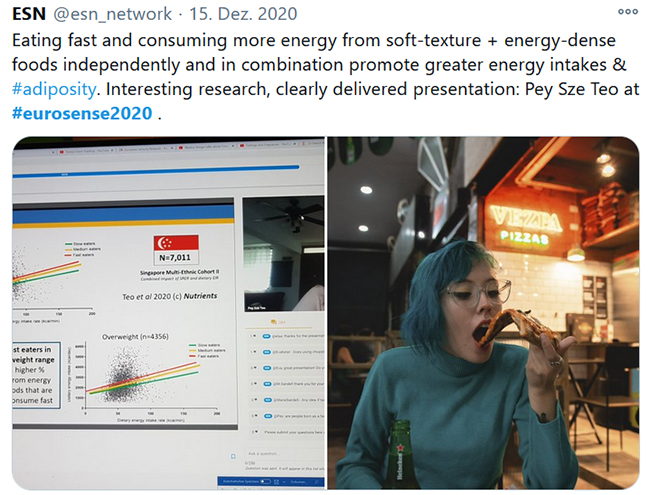
The Fourth Industrial Revolution
After the lunch break, and visiting the posters and the exhibitions, it was time for the next keynote. The topic: How sensory and consumer scientists will thrive in the Fourth Industrial Revolution. The speaker, John Ennis (Aigora), whom we had the pleasure to have as a guest speaker at our recent ESN meeting, paints an exciting big picture of the future of sensory and consumer science.
To be part of the future, sensory experts shouldn´t just try to make existing methods and approaches faster and better; they should also try out new opportunities by using new technologies that are fusing the physical, digital and biological worlds., For those interested in delving deeper into the subject, John Ennis recommended Klaus Schwab´s book, The Fourth Industrial Revolution.

Sensory research & Covid-19
One of the afternoon workshops, “COVID-19 and sensory science: implications on perception, consumer preferences and testing”, demonstrated how flexibly sensory research companies adapted to the new situation.
Martin Kern (SAM, ESN Co-Chair) laid out how his company switched seamlessly from lab to home testing. He coined the term “CLT @ Home” and used research data to confirm that the results were not hampered by the location switch. (If you want to know more about how ESN members, including SAM, adapted their research during the pandemic, visit the video section of our website.)

How did the average person react to the pandemic when it came to food? Valeri Almli (Nofima) presented first results. Some good changes took place. For example, there was an uptick in the consumption of fruits and vegetables.
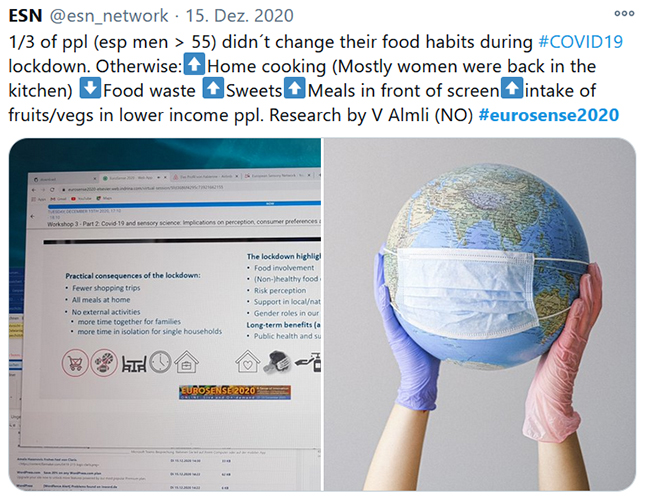
During the pandemic, a group of researchers got together, formed the Global Consortium for Chemosensory Research (GCCR), and conducted and published impressive COVID-19-related research. This agile, innovative, and highly interdisciplinary research is a blueprint for future research in the sensory world.
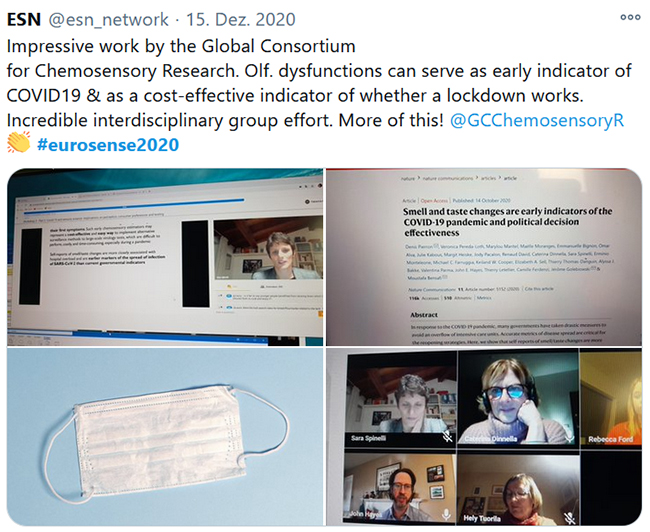
Food and Inequality
On the last day of EuroSense, Hedwig te Molder (Vrije University) addressed the important topic of healthy eating and socioeconomic status.
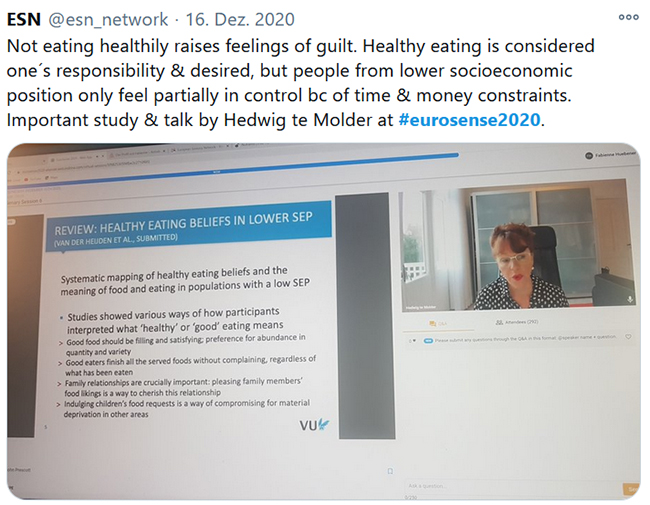
Multisensory Experiences
The next to last keynote speaker was Marianna Obrist (University College London), who spoke on the subject “Designing multisensory experiences”. For more on the subject, the book “Multisensory Experiences”, which Mariana Obrist wrote together with Carlos Velasco, is an invaluable read.

Know the consumer better than they know themselves: implicit methods
After the morning keynotes, it was time again for three parallel sessions. ESN presented the workshop “Practical application of implicit tools and adaptations to enhance their value”. The workshop was dedicated to implicit methods, a research area in which ESN and ESN members have been heavily invested for many years.
Thanks to ESN member isi, the 2020 EuroSense workshop also included a hands-on example of a two-item-forced-choice task for everybody to experience. The virtual attendees watched Donato Cereghetti (Firmenich), Théo Hertier and Claire Quinton (Merieux), Ingunn Berget (Nofima), Alexandra Kraus and Jasmin Weber (isi) present their experiences with implicit testing, or as Alexandra Kraus emphasized “semi-implicit” testing.
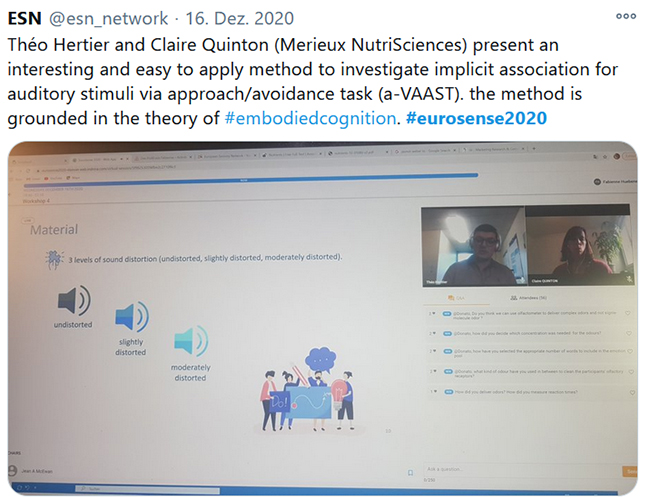
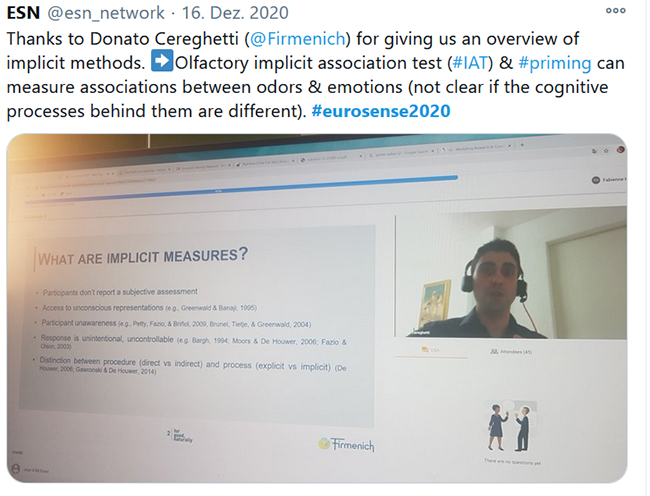
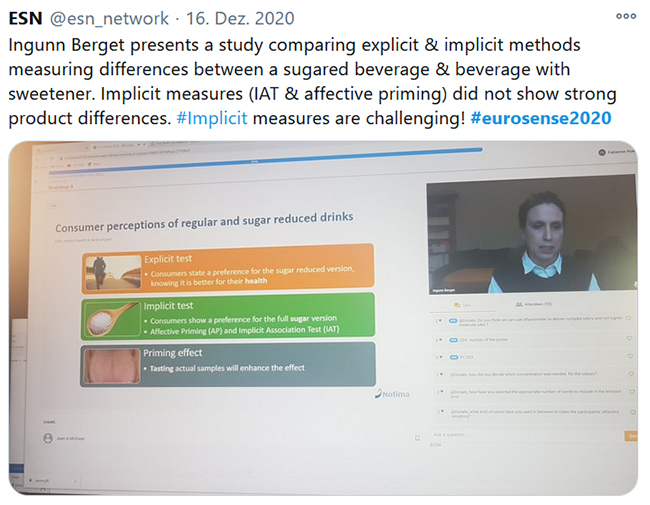

A Sense of Earth
The conference ended with a keynote from Victoire Dairou (Danone). He discussed how to engage people towards healthier food and planet-positive habits – a perfect transition to the topic of the next EuroSense2022 in Turku, Finland: A Sense of Earth.
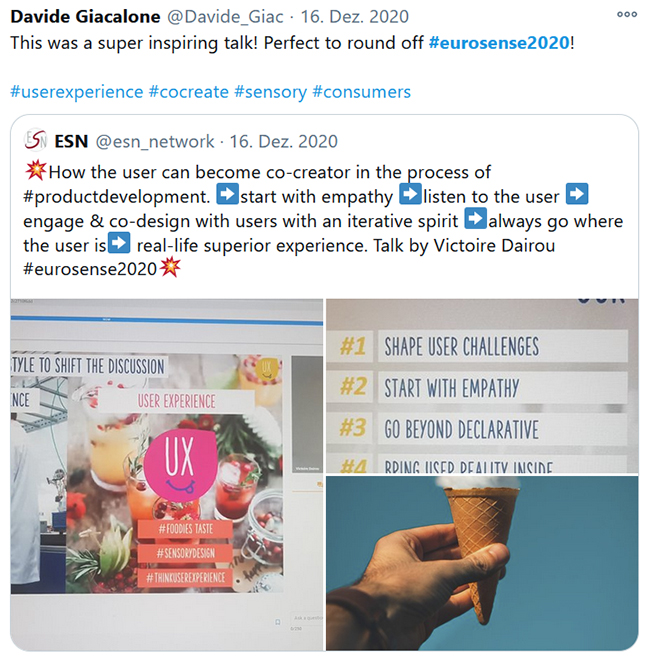
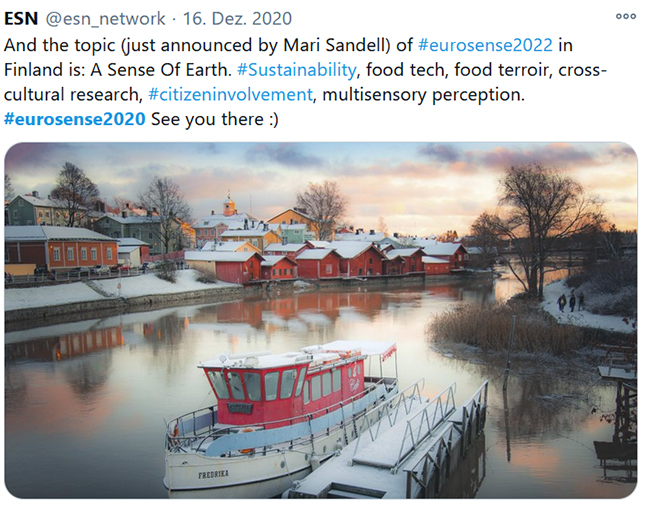
This was an exceptionally well-rounded, all-encompassing and exciting conference. Hats off to the organizers!

PS: Those interested in reading a summary of EuroSense2018 please follow this link: https://www.esn-network.com/news/single-view/article/eurosense-summary/
(Written December 2020, author: Fabienne Hübener)


